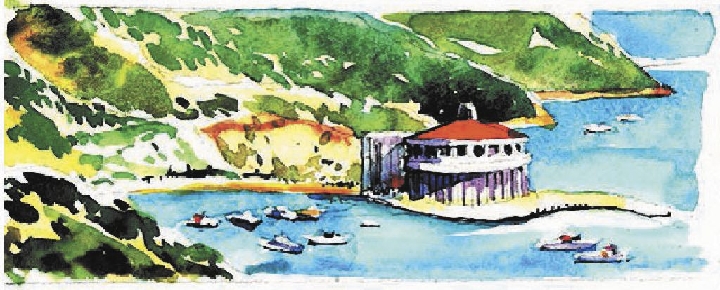Santa Catalina Island a scenic, quiet destination

Santa Catalina Island’s enduring appeal draws visitors all year, averaging about a million annually. Even in the slack winter season, busy ferries from five mainland ports daily carry hundreds of people to and from Catalina’s main harbor at the tiny community of Avalon. Others arrive by helicopter. A few boat to Avalon or secluded coves aboard their own craft. Some come just for the day, while others stay overnight or longer. Many come equipped for camping on the island.
One of the chain of Channel Islands, Catalina retains an air of romance and mystery. Its human history covers the several thousand years since native people first ventured the 22 miles from the mainland to explore the 50-mile-long island. These sea-going folk founded villages, fished the ocean and mined Catalina’s deposits of admired soapstone, which they traded to other groups along the coast.
Spanish explorers first claimed the island in 1542, then forgot about it. It got its name from its rediscovery in 1602 on St. Catherine’s Day. It soon drew mariners, fishermen, sea-going hunters of marine mammals and nefarious types such as smugglers and human traffickers from many nations. Exposure to diseases from all those visitors brought disaster to the indigenous people. By 1830, the island had no permanent residents.
Under a Spanish land grant, the island became private property, which changed hands several times. In 1887, a Michigan real estate speculator bought the island for $200,000 with the idea of creating a resort destination. He laid out a town and called it Avalon, had a land auction, built the first hotel, connected Catalina to the mainland with daily steamers and ran out of money.
In 1891, new owners established the Santa Catalina Island Co. to develop more resort amenities, including a dance pavilion, a sea wall, bathhouses, rental tent houses and stagecoach tours of the island’s interior on the first dirt roads. Those years of swift development received a disastrous blow with a fire in 1915 that burned about half of Avalon.
Chewing gum magnate William Wrigley fell for the island during a visit and bought up the shares of the distressed company in 1919. He built a beautiful house on a hill overlooking the harbor. Owner of the Chicago Cubs ball team, Wrigley installed a playing field visible from his mansion where the players met for spring training for most of three decades. He continued Catalina’s development, including construction of an art deco dance hall and improving transportation with two large steamships, each capable of carrying 1,500 passengers. In 1929, the dance hall was replaced by the iconic Catalina Casino, with its theater on the lower levels and the largest dance floor in the world on the upper levels. The building today houses a popular museum, which conducts tours of the building.
Under Wrigley ownership, Catalina gained media attention, provided the setting for popular films, drew Hollywood celebrities and lured increasing numbers of tourists, except during World War II, when the whole island was taken over by United States military services. In 1975, the Wrigley holdings of 88 percent of the island were turned over to the nonprofit Catalina Island Conservancy. It remains dedicated to balancing conservation, education and recreation on the island.
Today, Santa Catalina Island continues to entrance its visitors. They stay in hotels, bed and breakfast inns (including the Wrigley mansion), beach cottages, condos or rental tent houses much like the early ones. The island has several developed campgrounds, including the one in Avalon, several primitive boat-in camping areas, and various private summer camps and educational camps. Only Avalon is open to the public. Visitors must have permits or take tours to visit elsewhere on the island.
In Avalon, shops and eateries crowd the beach and pier. Intriguing streets thread through charming residential areas. Since most cars and trucks are prohibited, visitors explore on foot, by bike, on Segways or in golf carts, all available for rent or provided by hotels. A pair of zip lines at the edge of town challenge the adventurous. Adventures at sea include glass-bottom boat tours, fishing, rental rafts and kayaks, scuba diving, snorkeling and parasailing.
Margo Bartlett Pesek’s column appears on Sundays.